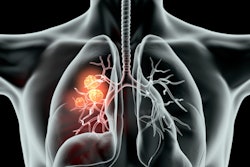
Two studies presented at the International Association for the Study of Lung Cancer (IASLC) world conference look at the use of higher radiation boost doses for lung cancer.
In the first, Dutch investigators found excellent local control rates with dose escalation to the whole planning target. In the second, U.S. researchers demonstrated the feasibility and safety of performing biologically adaptive radiation therapy escalation in a multicenter setting in patients with stage III non-small cell lung cancer (NSCLC).
A team led by Dr. Saskia Cooke from the Netherlands Cancer Institute in Amsterdam examined 107 patients with stage II-III NSCLC who were treated with hypofractionated dose escalation to either the primary tumor as a whole (arm A) or the high FDG-uptake region inside the planned target (> 50% maximum standardized uptake value, [SUVmax]; arm B).
In arms A and B, median gross tumor volume for the primary tumor was 100 cm3 and 115 cm3, while median gross tumor volume was 18 cm3 and 20 cm3. Median fraction dose was 3.25 Gy to planning target volume to the entire primary tumor and 3.5 Gy to planning target volume 50% SUVmax, resulting in total planned physical dose of 78 Gy and 84 Gy, in 24 fractions.
Of the 12 patients in arm A that experienced locoregional failure, two had local failure without regional failure and nine had regional failure without locoregional failure. Of the 15 patients in arm B, four had locoregional failure without regional failure and 10 had regional failure without locoregional failure.
The two-year cumulative incidence of locoregional failure was 11% in arm A and 18% in arm B. The two-year cumulative incidence of regional failure was 28% in arm A and 25% in arm B.
For the second study, Dr. Feng-Ming (Spring) Kong, PhD, from Case Western Reserve University in Cleveland, Ohio, and colleagues sought to determine whether adaptive isotoxic radiation dose escalation to midtreatment FDG-PET provides superior local tumor control compared with a standard uniform dose of 60 Gy in patients with stage III NSCLC.
The research team enrolled 127 patients with stage III NSCLC who were medically fit for concurrent chemoradiation. They randomly assigned patients by a 1:2 ratio to a standard (60 Gy) arm or to an adaptive-therapy arm, with dose individualized to 20 Gy mean lung dose, and adapted to residual tumor on the midtreatment FDG-PET/CT. All patients had FDG-PET performed at 40 Gy midtreatment, with radiation therapy delivered in 30 daily fractions.
The adaptive arm consisted of 2.2 Gy per day for 21 daily fractions followed by an adaptive radiation therapy boost to midtreatment FDG-PET target using a variable prescription of 2.2-3.8 Gy per day for the final nine daily fractions.
The two-year overall local-regional tumor progression-free rates were 59.5% on the standard arm and 54.6% on the adaptive arm. There were no significant differences in overall survival, progression-free survival, or lung cancer-specific survival between the two arms, according to the researchers.



















